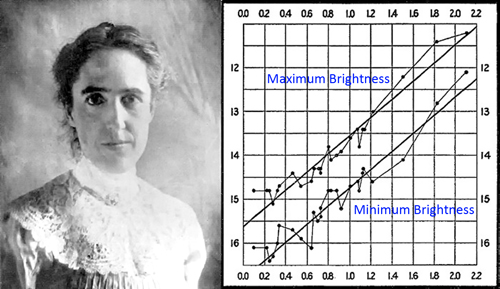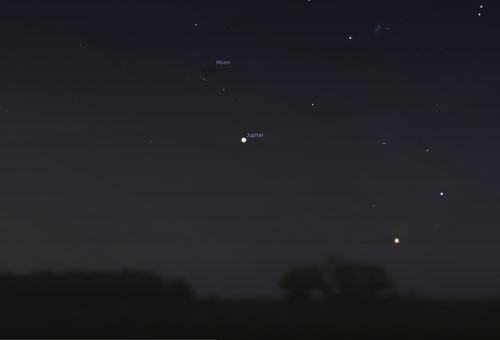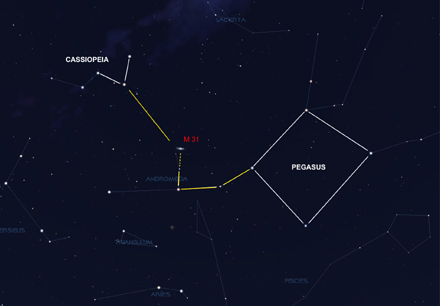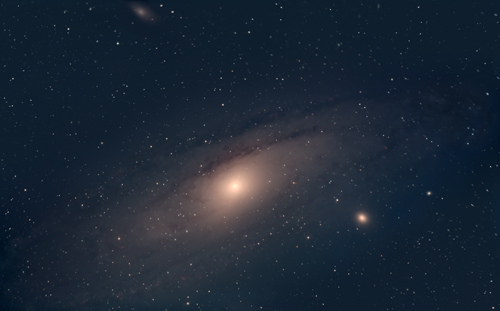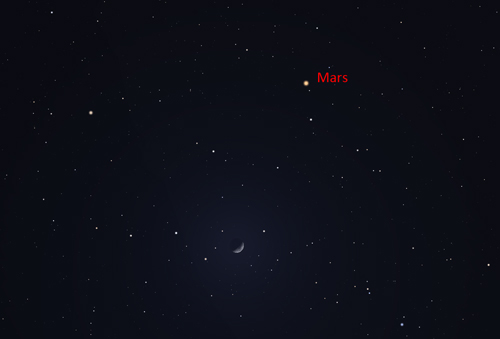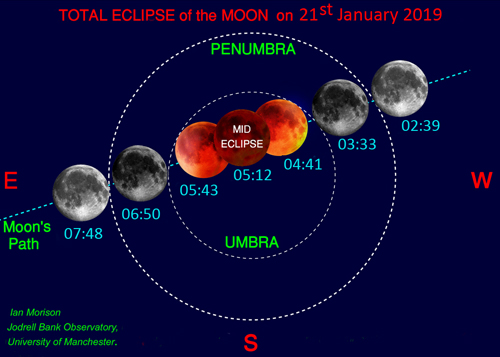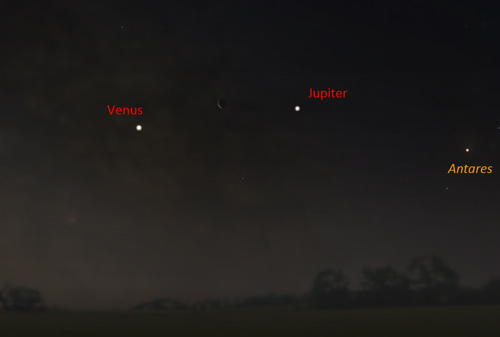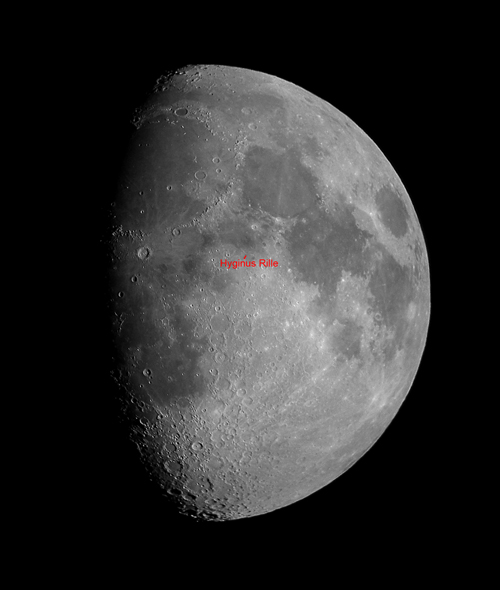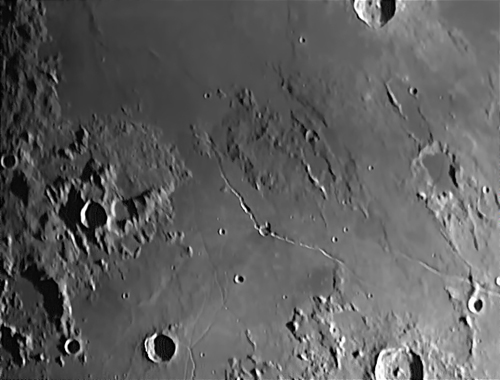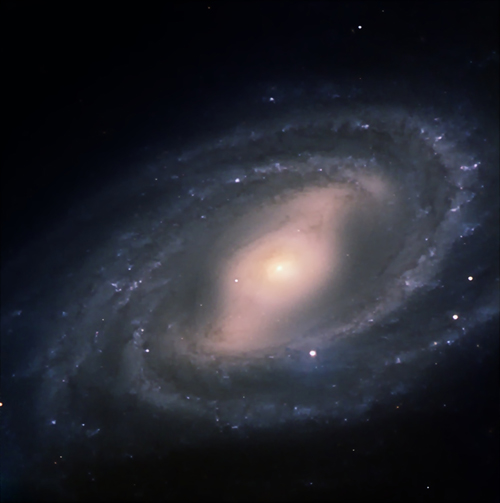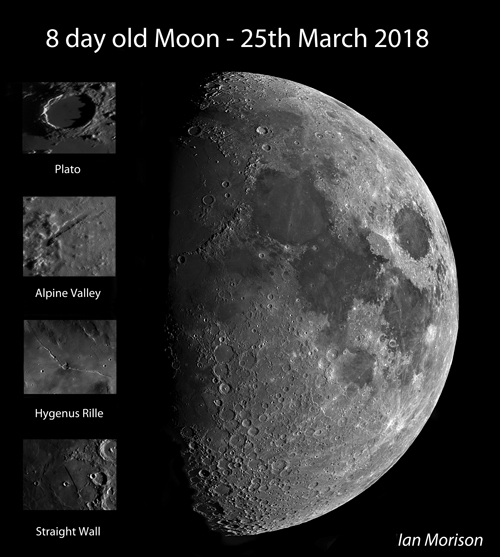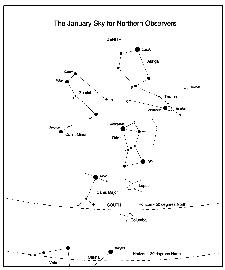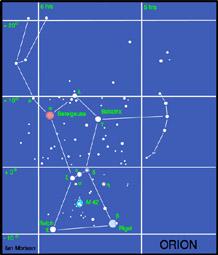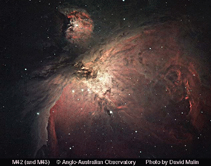The Night Sky January 2019
Compiled by Ian Morison
Note the Total Lunar eclipse on the morning of the 21st of January
This page, updated monthly, will let you know some of the things that you can look out for in the night sky. It lists the phases of the Moon, where you will see the naked-eye planets and describes some of the prominent constellations in the night sky during the month.
New(ish)
The author's: Astronomy Digest
which, over time, will provide useful and, I hope, interesting articles for all amateur astronomers. A further aim is to update and add new material to link with the books recently published by Cambridge University Press and which are described on the home page of the digest. It now includes well over 50 illustrated articles.Image of the Month
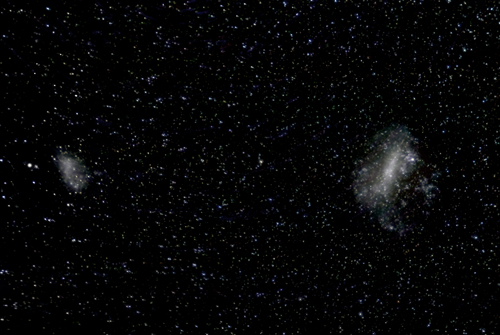
Homage to Henrietta Leavitt
Image:Ian Morison
Henrietta Swan Leavitt joined the Harvard University Observatory in 1903 when its director, Edward Charles Pickering, asked to study variable stars in the Large and Small Magellanic Clouds whose brightnesses had been recorded on photographich plates taken with the Bruce Astrograph of the Boyden Station of teh Observatory in Arequipa, Peru. Leavitt looked carefully at the relation between the periods and brightness of a sample of 25 Cephied Variables in the Small Magellanic Cloud (LMC) and found that there was a simple relationship between their apparent brightness and their periods. From the known distance of the LMC she could find their absolute brightnesses and showed, for example, that a Cepheid variable with a period of 30 days was some 10,000 times brighter than our Sun.
Cepheid variable stars are some of the brightest in the heavens and could thus be observed at great distances. Edwin Hubble, using the 100 inch Hooker Telescope at Mount Wilson Observatory, discovered a Cepheid Variable with a period of 31 days in the Andromeda Nebula (such objects were then called 'White nebula' which many thought were within our own galaxy). He was thus able to calculate its distance and showed that it was far beyond or own galaxy and thus a galaxy in its own right. Later, combining his distace measurments of the 25 galaxies whose velocities of approach or recession had been measured by Vesto Slipher at the Lowell Observatory, he found a linear relationship between the recession velocity and distance. This showed that the Universe was expanding. Projecting backwards in time until the Universe had no size, he was thus able to determine its age.
The linear relationship has, not surprisingly, been called the 'Hubble Law' and the related coefficient of expansion the Hubble Constant (now thought to be ~68). However Georges Lemaitre had derived an identical law from Eintein's Theory of General Relativity and published this in 1927 in an obscure French Journal so was hardly known. Recognising his work, 'The International Astronomical Union' voted in October 2018 for the 'Hubble Law' to become known as the 'Hubble-Lemaitre' Law
An article 'Imaging the Magellanic Clouds ...', describing how this image was created can be found in the digest whose link is above.
Highlights of the Month
January 3rd - before dawn: Jupiter below a very thin crescent Moon.
Looking southeast before dawn one should, if clear, be able to easily spot Jupiter lying below a very thin crescent Moon. The red giant star, Antares is down to the right of Jupiter.
Around the 6th of January (with no Moon in the sky): find M31 - The Andromeda Galaxy - and perhaps M33 in Triangulum
In the evening, the galaxy M31 in Andromeda is visible in the south The chart provides two ways of finding it:
1) Find the square of Pegasus. Start at the top left star of the square - Alpha Andromedae - and move two stars to the left and up a bit. Then turn 90 degrees to the right, move up to one reasonably bright star and continue a similar distance in the same direction. You should easily spot M31 with binoculars and, if there is a dark sky, you can even see it with your unaided eye. The photons that are falling on your retina left Andromeda well over two million years ago!
2) You can also find M31 by following the "arrow" made by the three rightmost bright stars of Cassiopeia down to the lower right as shown on the chart.
Around new Moon (6th Jan) - and away from towns and cities - you may also be able to spot M33, the third largest galaxy after M31 and our own galaxy in our Local Group of galaxies. It is a face on spiral and its surface brightness is pretty low so a dark, transparent sky will be needed to spot it using binoculars (8x40 or, preferably, 10x50). Follow the two stars back from M31 and continue in the same direction sweeping slowly as you go. It looks like a piece of tissue paper stuck on the sky just a bit brighter than the sky background. Good Hunting!
January12th - evening: Mars above a waxing Moon
Looking south in the evening if clear, Mars will be seen lying above a waxing crescent Moon.
January 21st - a Total Eclipse of the Moon
If clear in the hours before dawn, we should be able to see a Total Eclipse of the Moon as it moves through the Earth's shadow at times indicated on the chart. A nice photo opportunity.
January 31st - just before dawn: a thin crescent Moon lies between Jupiter and Venus
If clear just before dawn, and given a low horizon towards the southeast, one should be able to see a thin waning crescent Moon lying between Jupiter (on its right) and Venus shining brightly to its left. Antares is down to the lower left. A nice photo opportunity.
January 13th and 26th evening: The Hyginus Rille
For some time a debate raged as to whether the craters on the Moon were caused by impacts or volcanic activity. We now know that virtually all were caused by impact, but it is thought that the Hyginus crater that lies at the centre of the Hyginus Rille may well be volcanic in origin. It is an 11 km wide rimless pit - in contast to impact craters which have raised rims - and its close association with the rille of the same name associates it with internal lunar events. It can quite easily be seen to be surrounded by dark material. It is thought that an explosive release of dust and gas created a vacant space below so that the overlying surface collapsed into it so forming the crater.
M109 imaged with the Faulkes Telescope
The Galaxy M109, imaged by Daniel Duggan.
This image was taken using the Faulkes Telescope North by Daniel Duggan - for some time a member of the Faulkes telescope team. It shows the barred spiral galaxy M109 that lies at a distance of 83 million light years in the constellation of Ursa Major. It is the brightest galaxy in the Ursa Major group of some 50 galaxies. Our own Milky Way galaxy is now thought to be a barred spiral like M109.
Learn more about the Faulkes Telescopes and how schools can use them: Faulkes Telescope"
Observe the International Space Station

The International Space Station and Jules Verne passing behind the Lovell Telescope on April 1st 2008.
Image by Andrew Greenwood
Use the link below to find when the space station will be visible in the next few days. In general, the space station can be seen either in the hour or so before dawn or the hour or so after sunset - this is because it is dark and yet the Sun is not too far below the horizon so that it can light up the space station. As the orbit only just gets up the the latitude of the UK it will usually be seen to the south, and is only visible for a minute or so at each sighting. Note that as it is in low-earth orbit the sighting details vary quite considerably across the UK. The NASA website linked to below gives details for several cities in the UK. (Across the world too for foreign visitors to this web page.)
Note: I observed the ISS three times recently and was amazed as to how bright it has become.
Find details of sighting possibilities from your location from: Location Index
See where the space station is now: Current Position
The Moon

The Moon at 3rd Quarter. Image, by Ian Morison, taken with a 150mm Maksutov-Newtonian and Canon G7.
Just below the crator Plato seen near the top of the image is the mountain "Mons Piton". It casts a long shadow across the maria from which one can calculate its height - about 6800ft or 2250m.
| new moon | first quarter | full moon | last quarter |
|---|---|---|---|
| January 6th | January 14th | January 21st | Janiary 27th |
Some Lunar Images by Ian Morison, Jodrell Bank Observatory: Lunar Images
A World Record Lunar Image
To mark International Year of Astronomy, a team of British astronomers have made the largest lunar image in history and gained a place in the Guinness Book of Records! The whole image comprises 87.4 megapixels with a Moon diameter of 9,550 pixels. The resolution of ~0.4 arc seconds allows details as small as 1km across to be discerned! The superb quality of the image is shown by the detail below of Plato and the Alpine Valley. Craterlets are seen on the floor of Plato and the rille along the centre of the Alpine valley is clearly visible. The image quality is staggering! The team of Damian Peach, Pete lawrence, Dave Tyler, Bruce Kingsley, Nick Smith, Nick Howes, Trevor Little, David Mason, Mark and Lee Irvine with technical support from Ninian Boyle captured the video sequences from which 288 individual mozaic panes were produced. These were then stitched together to form the lunar image.
Please follow the link to the Lunar World Record website and it would be really great if you could donate to Sir Patrick Moore's chosen charity to either download a full resolution image or purchase a print.
The 8 day old Moon
This image was taken by the author on a night in March 2018 when the Moon was at an elevation of ~52 degrees and the seeing was excellent. This enabled the resolution of the image to be largely determined by the resolution of the 200 mm aperture telescope and the 3.75 micron pixel size of the Point Grey Chameleon 1.3 megapixel video camera. The use of a near infrared filter allowed imaging to take place before it was dark and also reduced the effects of atmospheric turbulence. The 'Drizzle' technique developed by the Hubble Space Telescope Institute (HSTI) was used to reduce the effective size of the camera's pixels to allow the image to be well sampled. Around 100 gigabytes of data, acquired over a 2 hour period, was processed to produce images of 54 overlapping areas of the Moon which were then combined to give the full lunar disk in the free 'stitching' program Microsoft ICE. A further HSTI development called 'deconvolution sharpening' was then applied to the image. The Moon's disk is ~6,900 pixels in height and has a resolution of 0.6 to 0.7 arc seconds. Interestingly, as seen in the inset image, the rille lying along the centre of the Alpine Valley is just discernable and this is only ~0.5 km wide! [Due to size limitations the large image is 2/3 full size.]
The Planets
Jupiter
Jupiter starts the month rising around 5 a.m.,and brightens from magnitude -1.9 to -1.9 as the month progresses whilst its angular size increases slightly from 31.8 to 33.6 arc seconds. The highlight above shows how it combines with Venus to give us a wonderful view in the East before dawn.
Saturn
Saturn passes behind the Sun on the 2nd of January so will not be visible in the pre-dawn eastern sky until around the third week of the month shining with a magnitude of +0.6. With a disk of ~15 arc seconds across and with rings spanning over twice this, it will rise some one and a half hours before the Sun by month's end.
Mercury
Mercury might just be glimpsed very low in the southeast just before sunrise shining at magnitude -0.4 in the first few days of the month. Binoculars could well be needed to reduce the background glare, but please do not use them after the Sun has risen.
Mars
Mars, though fading from +0.5 to +0.9 magnitudes during the month, remains prominent in the southern sky after sunset at an elevation of ~36 degrees, increasing to 41 degrees during January as it moves north-eastwards across the constellation of Pisces. (If only it could have been at this elevation when at closest approach last year!) Its angular size falls from 7.5 arc seconds to 6 arc seconds during the month so one will not be able to spot any details on its salmon-pink surface.
Venus
Venus reaches greatest elongation west some 47 degrees awau form the Sun on January 6th so dominates the eastern sky rising some 3 hours before the Sun. It begins January with a dazzling magnitude of -4.6. Its angular size reduces from 26.3 to 19.4 arc seconds during the month as it moves away from the Earth but, at the same time, the precentage illuminated disk (its phase) increases from 47% to 62% - which is why the brightness only reduces from -4.6 to -4.3 magnitudes. See the highlight above when it lies close to Jupiter.
The Stars
The Mid to Late Evening January Sky
This map shows the constellations seen in the south around midnight. The brilliant constellation of Orion is seen in the south. Moving up and to the right - following the line of the three stars of Orion's belt - brings one to Taurus; the head of the bull being outlined by the V-shaped cluster called the Hyades with its eye delineated by the orange red star Aldebaran. Further up to the right lies the Pleaides Cluster. Towards the zenith from Taurus lies the constellation Auriga, whose brightest star Capella will be nearly overhead. To the upper left of Orion lie the heavenly twins, or Gemini , their heads indicated by the two bright stars Castor and Pollux. Down to the lower left of Orion lies the brightest star in the northern sky, Sirius, in the consteallation Canis Major. Finally, up and to the left of Sirius is Procyon in Canis Minor. There is also information about the constellation Ursa Major, seen in the north,in the constellation details below.
The constellation Taurus
Taurus is one of the most beautiful constellations and you can almost imagine the Bull charging down to the left towards Orion. His face is delineated by the "V" shaped cluster of stars called the Hyades, his eye is the red giant star Aldebaran and the tips of his horns are shown by the stars beta and zeta Tauri. Although alpha Tauri, Aldebaran, appears to lie amongst the stars of the Hyades cluster it is, in fact, less than half their distance lying 68 light years away from us. It is around 40 times the diameter of our Sun and 100 times as bright.

AAO Image of the Pleiades, M45, by David Malin
To the upper right of Taurus lies the open cluster, M45, the Pleiades. Often called the Seven Sisters, it is one of the brightest and closest open clusters. The Pleiades cluster lies at a distance of 400 light years and contains over 3000 stars. The cluster, which is about 13 light years across, is moving towards the star Betelgeuse in Orion. Surrounding the brightest stars are seen blue reflection nebulae caused by reflected light from many small carbon grains. These relfection nebulae look blue as the dust grains scatter blue light more efficiently than red. The grains form part of a molecular cloud through which the cluster is currently passing. (Or, to be more precise, did 400 years ago!)
Close to the tip of the left hand horn lies the Crab Nebula, also called M1 as it is the first entry of Charles Messier's catalogue of nebulous objects. Lying 6500 light years from the Sun, it is the remains of a giant star that was seen to explode as a supernova in the year 1056. It may just be glimpsed with binoculars on a very clear dark night and a telescope will show it as a misty blur of light.
Its name "The Crab Nebula" was given to it by the Third Earl of Rosse who observed it with the 72 inch reflector at Birr Castle in County Offaly in central Ireland. As shown in the drawing above, it appeared to him rather lile a spider crab. The 72 inch was the world's largest telelescope for many years. At the heart of the Crab Nebula is a neutron star, the result of the collapse of the original star's core. Although only around 20 km in diameter it weighs more than our Sun and is spinning 30 times a second. Its rotating magnetic field generate beams of light and radio waves which sweep across the sky. As a result, a radio telescope will pick up very regular pulses of radiation and the object is thus also known a Pulsar. Its pulses are monitored each day at Jodrell Bank with a 13m radio telescope.
The constellation Orion
Orion, perhaps the most beautiful of constellations, will be seen in the south at around 11 - 12 pm during January. Orion is the hunter holding up a club and shield against the charge of Taurus, the Bull up and to his right. Alpha Orionis, or Betelgeuse, is a read supergiant star varying in size between three and four hundred times that of our Sun. The result is that its brightness varies somewhat. Beta Orionis, or Rigel, is a blue supergiant which, at around 1000 light years distance is about twice as far away as Betelgeuse. It has a 7th magnitude companion. The three stars of Orion's belt lie at a distance of around 1500 light years. Just below the lower left hand star lies a strip of nebulosity against which can be seen a pillar of dust in the shape of the chess-board knight. It is thus called the Horsehead Nebula. It shows up very well photographically but is exceedingly difficult to see visually - even with relativly large telescope.
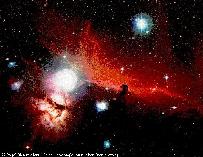
The Horsehead Nebula: Anglo Australian Observatory
Beneath the central star of the belt lies Orion's sword containing one of the most beautiful sights in the heavens - The Orion Nebula. It is a region of star formation and the reddish colour seen in photographs comes from Hydrogen excited by ultraviolet emitted from the very hot young stars that make up the Trapesium which is at its heart. The nebula, cradling the trapesium stars, is a beautiful sight in binoculars or, better still, a telescope. To the eye it appears greenish, not red, as the eye is much more sensitive to the green light emitted by ionized oxygen than the reddish glow from the hydrogen atoms.
The constellation Ursa Major
The stars of the Plough, shown linked by the thicker lines in the chart above, form one of the most recognised star patterns in the sky. Also called the Big Dipper, after the soup ladles used by farmer's wives in America to serve soup to the farm workers at lunchtime, it forms part of the Great Bear constellation - not quite so easy to make out! The stars Merak and Dubhe form the pointers which will lead you to the Pole Star, and hence find North. The stars Alcor and Mizar form a naked eye double which repays observation in a small telescope as Mizar is then shown to be an easily resolved double star. A fainter reddish star forms a triangle with Alcor and Mizar.
Ursa Major contains many interesting "deep sky" objects. The brightest, listed in Messier's Catalogue, are shown on the chart, but there are many fainter galaxies in the region too. In the upper right of the constellation are a pair of interacting galaxies M81 and M82 shown in the image below. M82 is undergoing a major burst of star formation and hence called a "starburst galaxy". They can be seen together using a low power eyepiece on a small telescope.
Another, and very beautiful, galaxy is M101 which looks rather like a pinwheel firework, hence its other name the Pinwheel Galaxy. It was discovered in1781 and was a late entry to Messier's calalogue of nebulous objects. It is a type Sc spiral galaxy seen face on which is at a distance of about 24 million light years. Type Sc galaxies have a relativly small nucleus and open spiral arms. With an overall diameter of 170,000 light it is one of the largest spirals known (the Milky Way has a diameter of ~ 130,000 light years).

M101 - The Ursa Major Pinwheel Galaxy
Though just outside the constellation boundary, M51 lies close to Alkaid, the leftmost star of the Plough. Also called the Whirlpool Galaxy it is being deformed by the passage of the smaller galaxy on the left. This is now gravitationally captured by M51 and the two will eventually merge. M51 lies at a distance of about 37 million light years and was the first galaxy in which spiral arms were seen. It was discovered by Charles Messier in 1773 and the spiral structure was observed by Lord Rosse in 1845 using the 72" reflector at Birr Castle in Ireland - for many years the largest telescope in the world.
Lying close to Merak is the planetary nebula M97 which is usually called the Owl Nebula due to its resemblance to an owl's face with two large eyes. It was first called this by Lord Rosse who drew it in 1848 - as shown in the image below right. Planetary nebulae ar the remnants of stars similar in size to our Sun. When all possible nuclear fusion processes are complete, the central core collpses down into a "white dwarf" star and the the outer parts of the star are blown off to form the surrounding nebula.


M97 - The Owl Planetary Nebula Lord Rosse's 1848 drawing of the Owl Nebula


